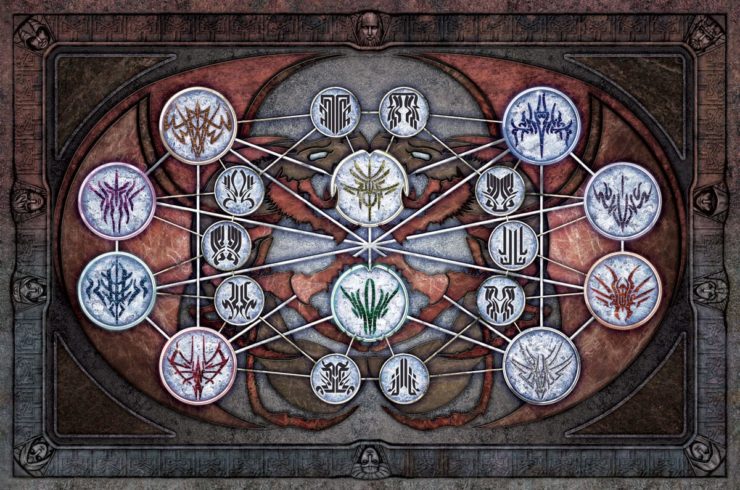Brandon Sanderson’s Cosmere novels, spearheaded by The Stormlight Archive and the Mistborn series, have become international bestsellers and developed a reputation for their rich worldbuilding, in-depth magic, and ambitious plotting. But another aspect of the books sets them apart: the art. While many fantasy books feature maps, and some include other artwork, Sanderson’s novels have become inextricably linked to a wide array of artwork. Whether it’s the sketches from Shallan’s journal in The Way of Kings, the striking Steel Alphabet in Mistborn, or the incredible Dragonsteel leatherbound editions of the books, it simply doesn’t feel like a Cosmere book without visual art accompanying the text.
Readers have come to expect plenty of art to feast upon when they open Cosmere books, and with the visual elements most prominent in The Stormlight Archive. Each volume has featured full-color endpaper illustrations, from Isaac Stewart’s Surgebinding and Voidbinding charts in The Way of Kings, to Michael Whelan’s Shallan painting in Words of Radiance, to Dan Dos Santos and Howard Lyons’ depictions of four Heralds in Oathbringer. Meanwhile, every book since The Alloy of Law has featured maps—highlighting more than just the standard locations.
The art in the Cosmere extends beyond the out-of-universe “extra content” feel: It tells a story alongside the text written by Sanderson. The maps are annotated by an in-universe character, named Nazh, who helps frame the more esoteric knowledge imparted by his boss Khrissala in the Ars Arcana. The paintings of the Heralds, or the star chart in Arcanum Unbounded, are depictions of art that exist in the Cosmere. They help readers piece together the buried clues and hints of the bigger story, or reinforce our understanding of the cultural norms in the various nations and worlds featured in the series.
And this is where Isaac Stewart, Art Director at Dragonsteel Entertainment, comes in. I had the chance to ask him a few questions about his work with Sanderson, especially as it relates to the Cosmere. This is an edited transcript.
Drew McCaffrey: How did you get your start working on art for Dragonsteel?
Isaac Stewart: So I met Brandon twice—the first time was in 1999, when I went to BYU and I found out about the Leading Edge magazine, and I decided to go and be a [slush] reader. I wasn’t terribly consistent; I met a lot of people there, who have gone on to do awesome things. For example, I met Karen and Peter [Ahlstrom, editorial staff at Dragonsteel] there in 1999. I would sit there and read submissions, but honestly, I was pretty shy. It didn’t occur to me until later that this group of friends sitting around reading submissions and discussing books and movies and comics were my people, and I’m extremely grateful I was able to reconnect with many of them later.
Buy the Book
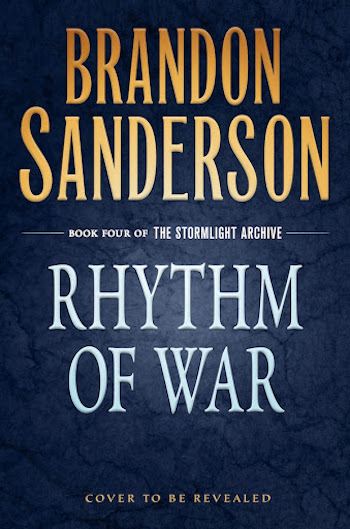

Rhythm of War
At the Leading Edge, I only interacted on a limited level with Brandon—met him a few times, that kind of thing—but he doesn’t remember. He was the editor at the time, and I don’t remember him from those group slush reading sessions, though it doesn’t mean he wasn’t there. I seem to recall he was often working on other editorial-type things.
So that was when I first met him, but later on, after I had graduated, I returned to school. By then I had a career in 3D animation, but I thought, “I’m gonna go back to school and become an optometrist.” It wasn’t out of the blue. I had a lot of science credits from back when I was a pre-dental major for two years. I thought there was no future for me in this art thing, so I’ll become an optometrist. I figured it’d be a solid job.
As an undergrad, I had taken the Science Fiction writing class from Dave Wolverton two years in a row. I started the year right after Brandon took it, and I really enjoyed it, so I looked it up again. Well, the university wouldn’t let me have very many credits, because I was a post-grad student, and I discovered that the writing class was taught by Brandon Sanderson. I recalled him from when he was at the Leading Edge, so I dropped all the science classes and ended up taking this writing class. Brandon and I were closer in age than the others in the class, and we wound up reconnecting and becoming friends.
After class, we would often go to dinner. One night, we were at Macaroni Grill, and I was drawing on the tablecloth there—they give you crayons to do this—and he looks over and he says “Oh, you draw?” And I said “Yeah, I have a degree in art.” And he asked if I wanted to do the maps for his next book. At this point Elantris had just barely come out.
So I said sure, and it turns out that was Mistborn. So anyway, that launched me into working on things with Brandon. That was 2005; in 2006, Mistborn came out. And until about 2013, I was just doing things as side projects for Brandon. I wound up saying, forget this optometry thing. I went back and worked as a freelance graphic designer for a while, as a hotel desk clerk for several months, but ended back in animation as a video game animator for several years. During that time, I’d go to the video game job, then I’d come home and work on freelance projects for Brandon.
Even at the time it never occurred to me that this could be a full-time gig. He paid me, but I told him he didn’t really need to pay me. I’d do these for free because this was a creative outlet that I didn’t have at my day job. In 2013, he hired me and [my wife] Kara full-time. I didn’t begin doing art all day every day. I was an administrative assistant part time and doing art part time. It quickly grew from that to now, where I’m managing a lot of other artists. So it’s expanded into something that I never imagined it could’ve turned into.
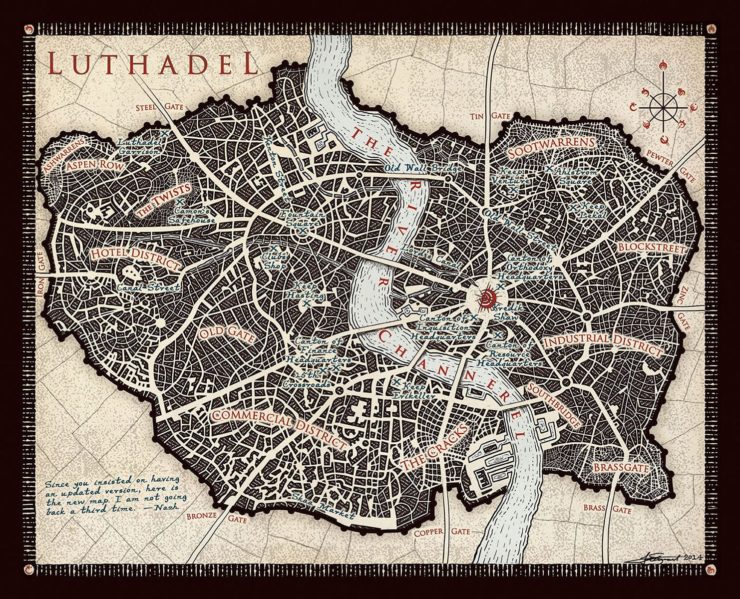
DM: Maybe this is a charged question, but do you think fantasy books need maps? Some authors are famous for refusing to include maps, while others—like Brandon—have maps in nearly every book.
IS: I don’t think they need them. But this is an answer that would have infuriated my 15-year-old self. I remember being pretty picky about books when I was in those formative years of finding fantasy novels. I’d pick up a book at the bookstore and think, “Hey, that’s an intriguing cover. Wait a second, there’s not a map? Forget about it.” But I’m also looking at things now from a different perspective. I’ve done so many maps for fantasy novels that it doesn’t matter to me anymore if there’s no map, because I just create the map in my head.
Are there books I wish had maps? Of course! Just because I want to know what the city looks like, or the country. Case in point is China Miéville. I love the Bas-Lag novels. They’re so inventive and creative. I wish there was kind of more an official map to go along with the books—that’s one example. But do they need them? No. I don’t think they do. And I don’t think we should be like my map-snobby 15-year-old self and not read a book because there’s not a map in it.
DM: Going hand-in-hand with the maps is the character Nazh, who annotates many of the in-universe maps. How much of Nazh was your idea? What about him appeals to you?
IS: The story behind Nazh is, I was in Brandon’s writing group when we were workshopping The Rithmatist. And there’s a character named Nalizar in that book. I could never remember his name, so I kept calling him Nazrilof. So it became this running gag with Brandon, like… “Nalizar and Nazh are different people. Nazh is your alter ego, Isaac, and Nalizar is a character in The Rithmatist.”
When we got to The Alloy of Law, Brandon and I were firmly in the camp of including maps that are artifacts from the world. And we thought, where are they getting these? And who’s labeling them? Diana Wynne Jones wrote a book called The Tough Guide to Fantasyland, and there’s a map in the front that basically says that if a location is labeled on the map, then by golly you’re gonna go to the place during the course of the story. Fantasy maps have gotten this reputation of being kind of spoilery.
So when we got to the map of Elendel, we were looking at it, thinking if we only labeled the places that were necessary for the story, then we’re falling into this trope of fantasy. So how can we subvert this a bit? So, if the novel is compiled by Khriss, presumably, then maybe she has somebody who goes and gets the maps and labels them for her with pertinent information. It might still feel a little like “these labeled things are the important parts” but at least there’s an in-world reason why that is. That allowed us to develop a character around that. Brandon said, “Why don’t we have Nazh do this?” to which I agreed, and Brandon said, “Isaac, welcome to the Cosmere.”
Since then, Nazh’s role has grown into basically a sidekick for Khriss. Now, when working with Nazh, we think of him as a grumpy James Bond.
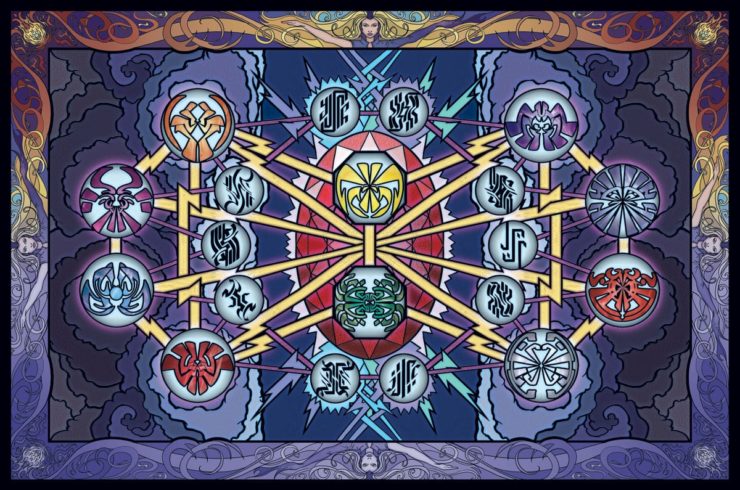
DM: Much of the focus of art from Dragonsteel is on visual media, but how involved are you with licensed merchandise like pins or the Mistborn coins?
IS: I’m pretty heavily involved in the merch. The coins are all designs that I did. I did my own rough drawings and then I sent them to Ben McSweeney to basically redraw them and make them look pretty. So those are canonical coins. The people at Shire Post Mint did an amazing job carving those out. I think those coins are amazing, and 110% of that is because Shire Post is awesome.
With the pins, I get files to Kara and she buys them. Now we’re starting to open up to other artists in that arena because I just don’t have the time to do those anymore. I’m usually reviewing things, like the art in the Brotherwise game that’s coming out, trying to fact check or give them art advice, and they’ve been doing an amazing job.
DM: Dragonsteel has collaborated with some very talented artists over the years. Do you usually approach them directly, or how do those collaborations work?
IS: Usually I approach people directly, or I talk to my artist friends and ask if they know anybody who has certain qualifications. So a lot of it is referral, and some of it is keeping an eye on fan art. Who’s producing professional fan art? Are they working as professional artists? So I find a lot of art that way.
The rerelease of the Alcatraz books was the beginning of that. Hayley Lazo was one of the first that I found. She was doing amazing fan art, turns out she was about to graduate with an art degree…so she was doing professional work, and she knocked it out of the park with the Alcatraz books. Those illustrations are so fun and work really well with the text of the book.
DM: Given the role of art in the Cosmere books, is there a series you feel particularly more or less attached to, based on the amount of art/work involved?
IS: You know, I feel like the obvious answer is The Way of Kings from The Stormlight Archive. That first book was kind of my trial by fire. I was working all day in video games, then coming home and working on The Way of Kings art long into the early hours of the morning. Wake up, repeat, a little like Groundhog Day for six months, but I did it because I love that book. As we’ve added more artists to The Stormlight Archive, the attachment to the world of Roshar is still there—I love what we’re doing—but it’s become this broader thing, and the ownership is spread out among more artists, which elevates the artistry of it, to be honest. So that’s the obvious answer.
But I still have a soft place in my heart for Mistborn. It’s where I got my start, it’s where I started learning my own professional mapping techniques and developing myself. I’m really happy with what happened with that, and with the Allomantic symbols. I’m always trying to replicate the magic that happened with those, how those became iconic.
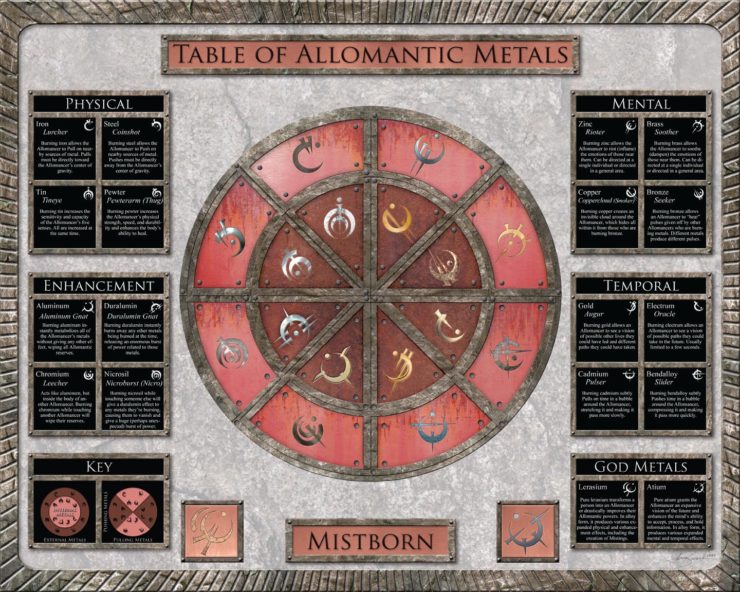
DM: Your input on the Cosmere goes beyond just the art—you wrote some of the Mistborn Era 2 broadsheet articles. Is there any plan for you to write more small-format things like that, continuing Nazh’s errands for Khriss?
IS: I wrote the Allomancer Jak story from Shadows of Self and the Nikki Savage story for The Bands of Mourning. Currently, we have an origin story for Nazh planned, which takes place on Threnody, as well as a few stories with Nikki Savage plotted out. It’s likely Nazh will probably show up again to torment her with his enigmatic grumpiness.
Nikki’s broadsheet story reads like an old serialized novel. In-world, she’s writing these things to be very sensationalized and bends the truth of true events to fit the needs of her story and to entertain her audience. Nikki’s novella is mostly plotted out. I just need to write it. It won’t be a first-person sensationalized newspaper serial, but the epigraphs will have pieces of the sensationalized stories. So you’ll read a chapter, and then the epigraph of the next chapter will be her sensationalized version of what happened in the previous chapter.
DM: A new Mistborn Era 2 novella—that’s awesome! Do you have any of your own writing projects going, which you can talk about?
IS: Originally my board book Monsters Don’t Wear Underpants, A Lift-the-Flap Book was going to published in August, but that has changed and my agent and I are looking for a publisher again. The book is completely finished. We just need to get it to a printer, and from there to the readers. If we can’t find a publisher in the next few months and it makes sense financially, I’ll probably run a small Kickstarter to finish off that project. Keep an eye on my Instagram for news about that.
Otherwise, most of my own writing right now is in the Cosmere. I’ve been hard at work on some fun things for Taldain that we can’t quite announce yet, but I’m bursting at the seams wanting to share the cool things that are going on there. Rest assured that as soon as we’re able, we’ll make some announcements.
Drew McCaffrey lives in Fort Collins, CO, where he’s spoiled by all the amazing craft beer. He co-hosts the Inking Out Loud podcast, covering science fiction and fantasy books (and some of that Colorado craft beer). You can find him on Twitter, talking about books and writing, but mostly just getting worked up about the New York Rangers.










